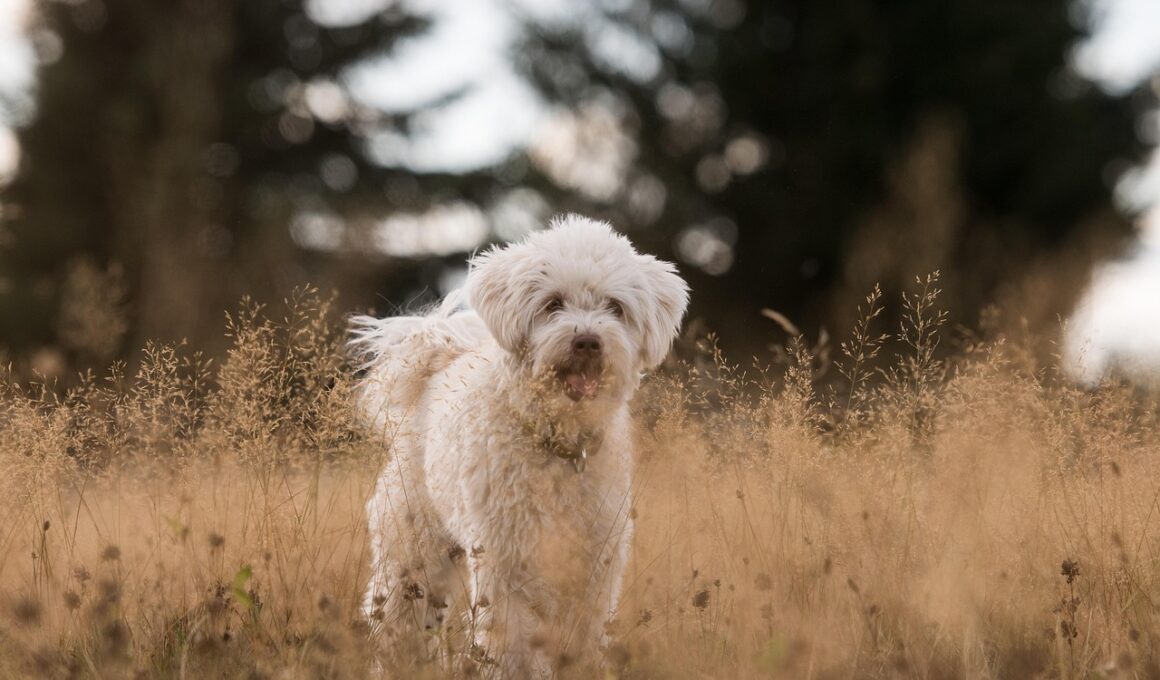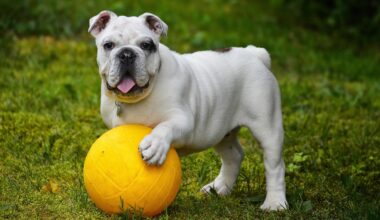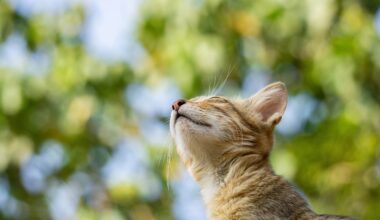Adapting to Unexpected Dog Behavior During Photography Sessions
Photography sessions with dogs can be incredibly rewarding, yet they often present unpredictable challenges. Whether you’re a professional or an amateur photographer, understanding canine behavior is crucial. Dogs are not only expressive animals but they can also communicate through their body language. As you prep for a session, be aware of common behaviors that can arise. Knowing the signs of anxiety, excitement, or even playfulness can help you adapt your approach effectively. For instance, if a dog starts to chew on their leash or darts away, consider it a signal to pause and engage with them positively. This responsiveness builds trust, ultimately leading to better portraits. Developing your ability to read a dog’s emotional state is paramount for captivating photography. Take a moment to observe the dog before taking photos to assess their comfort level. Ensure that the environment is calm and less overwhelming. Effective communication with the owner can also provide insights into the dog’s usual tendencies and triggers. Together, these practices will not only enhance the quality of your photos but also create a harmonious atmosphere for your furry subjects.
Preparation is essentially key to navigating unexpected behaviors during dog photography sessions. But what preparation entails can vary across different dog breeds. Each breed exhibits unique characteristics that might affect their reaction during a photo shoot. For example, energetic breeds like Border Collies or Jack Russells may require additional time to settle down. On the other hand, more reserved breeds such as Bulldogs might be slow to warm up. It’s advisable to research breed-specific behaviors to tailor your approach accordingly. Begin by familiarizing yourself with the dog before the actual shooting. You can bring along treats or favorite toys to coax them into desired poses. Remember, patience is critical. If the dog seems restless or distracted, momentarily step back and allow them some space. They may just need to explore their surroundings. Additionally, consider including some training commands such as ‘sit’ or ‘stay’, which can help guide the dog their desired position. If sessions become cumbersome, take periodic breaks for the dog’s benefit. Ultimately, keeping a playful atmosphere not only makes for better pictures but also ensures your canine clients feel safe and secure during the process.
Effective Techniques for Managing Behaviors
There are numerous techniques to manage unexpected behaviors during dog photography sessions. One method is engaging the dog through play to divert their attention from situations that may cause stress, such as loud noises or unfamiliar environments. Utilize toys to encourage desired behavior, such as fetching a ball or gently coaxing them by tossing treats. Another useful technique is to familiarize them with your camera equipment before starting the shoot. This can help diminish their apprehension towards large, strange objects. Additionally, using positive reinforcement techniques during the session can go a long way. If a dog exhibits good behavior, reward them immediately with a treat or praise. This creates a positive association with the photography session, making it more pleasant for both you and the dog. Surrounding the dog with comfortable and reassuring scents can also help relax them during the shoot. Items like an owner’s sweater or their favorite blanket can provide comfort. Remember, the goal is to create a low-pressure environment where the dog feels secure, leading to more natural and candid shots.
Another important aspect of handling unexpected behavior includes being proactive with the dog’s owner. Before the session, have a brief discussion about the dog’s behavioral quirks and idiosyncrasies. Owners know their pets best and can provide essential tips on what calms or excites them. For example, some dogs might be more responsive to certain commands, while others may have distractions like a favorite squeaky toy. This knowledge can drastically influence how you guide the photograph session. Moreover, consider scheduling your shoot during times when the dog is generally more relaxed. If the dog is known to be energetic, you might want to plan sessions post-exercise. Additionally, creating a friendly rapport with the owner can ease the dog’s anxiety. When dogs sense that their owners are at ease, they tend to reflect that calm energy. Explain your approach and methods to both the owner and the dog. Your enthusiasm will resonate, making the session more enjoyable for all parties involved. Therefore, openly communicating expectations leads to a more successful photographic experience.
Adapting to Ambience and Environment
The surroundings play a significant role in influencing a dog’s behavior during photography. Dogs are sensitive to their environments; loud noises or busy areas may distract or frighten them. Therefore, it’s advisable to scout locations suitable for the session beforehand. Choose environments that provide a sense of safety for the dog. Parks, backyards, and open spaces are often ideal, as they allow dogs to explore and feel at ease. Avoid crowded areas unless the dog is socialized and comfortable with many people. Also, consider factors like lighting and weather conditions. Overcast days can provide soft, diffused light, producing stunning portraits without the harsh shadows of bright sunlight. Alternatively, early morning or late afternoon offers golden hour light, ideal for captivating images. By adapting to these conditions, you’ll be better prepared to manage unexpected behaviors. Always have a backup plan if the weather doesn’t cooperate. Know how to work with natural elements—like using trees for shade. Observing how a dog interacts with their setting can also lead to inspirational photographic ideas. Embrace the ambience to enhance the experience and capture splendid shots.
One of the most crucial elements in adapting to unexpected behaviors is your own emotional state. Dogs are incredibly perceptive to human emotions, often mirroring the feelings of those around them. If you appear anxious or stressed, the dog may sense this and become agitated. Remaining calm and composed encourages the dog to mirror your behavior. Practice mindfulness techniques, like deep breathing, before the session. Additional preparations might include visualizing successful capturing moments and maintaining a positive mindset. The more relaxed you are, the easier it will be to engage the dog, creating an enjoyable experience for both of you. When issues arise, your positive response will reassure the dog, leading to desired behaviors. Make an effort to engage the dog actively, taking playful breaks as needed. Use joyfulness and affection in your interactions, forming a bond that shows the dog this is a fun process. Ultimately, the mood of the session sets the tone for producing incredible images. A cooperative dog will naturally yield lasting memories and pictures, showcasing their personality beautifully. Remember, dogs can be both your subject and your ally in creating stunning portraits.
Post-Session Reflection and Learning
After your photography session, it’s beneficial to reflect on what went well and what didn’t. Review the images captured and analyze moments where the dog felt most comfortable versus stressed. Acknowledge how different strategies worked, allowing you to grasp what improved the overall session. Documenting these insights can help influence your approach for future sessions. Communicate and share your findings with fellow dog photographers or online communities for additional support and perspectives. Furthermore, consider incorporating feedback from the dog’s owner regarding their pet’s behavior. Discussing the results will foster understanding about how photography can impact a dog’s emotional state and behavior. Learning from every experience enhances your skill set and makes you a more adaptable photographer. Seek out new techniques and trends in dog photography to continually evolve your methods. Embrace ongoing education by taking workshops and connecting with other professionals in the field. As you refine your skills, remember that patience and trial and error play vital roles. Your persistent efforts will ensure each subsequent session is more enjoyable, allowing you to create stunning dog portraits that speak to their unique personalities.
In conclusion, understanding dog behavior is vital for a successful photography experience. Proper preparation, active engagement with the dog and its owner, and adapting to the environment all contribute to capturing those perfect moments. Moreover, maintaining your calm emotional state sets the tone for the session, directly influencing the dog’s behavior. Post-session reflection allows you to learn from each experience, enhancing your photography skills for the future. By prioritizing these elements, you’ll create a stress-free atmosphere, allowing dogs to shine in photographs. Never forget that every dog is unique, with different preferences and personalities. Embracing these differences will not only yield better photographs but also build meaningful relationships with the dogs you photograph. This adaptability will make for a more pleasant experience, not only for you but for your canine clients as well. So, always put in the effort to create the best environment possible. In this practice, you’ll create not just beautiful images but memories that both you and the dog will cherish. An adaptable photographer is the key to capturing authentic and emotion-filled moments that resonate with audiences everywhere.


